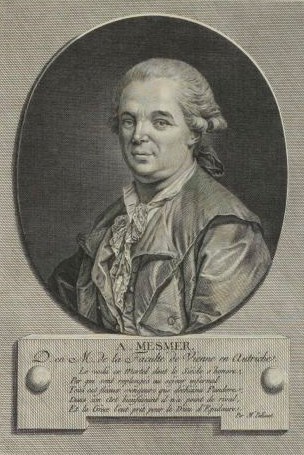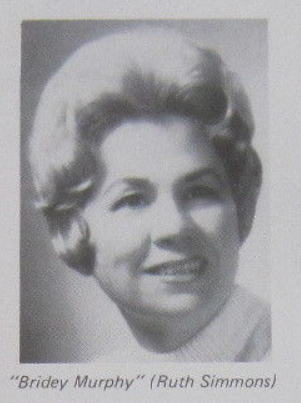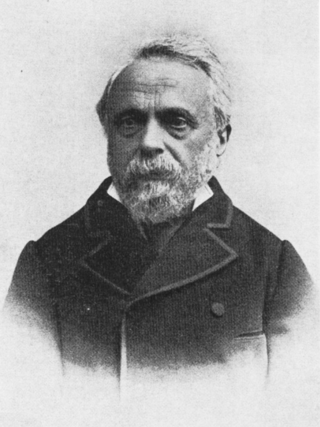Related Research Articles

Franz Anton Mesmer was a German physician with an interest in astronomy. He theorised the existence of a natural energy transference occurring between all animated and inanimate objects; this he called "animal magnetism", sometimes later referred to as mesmerism. Mesmer's theory attracted a wide following between about 1780 and 1850, and continued to have some influence until the end of the 19th century. In 1843, the Scottish doctor James Braid proposed the term "hypnotism" for a technique derived from animal magnetism; today the word "mesmerism" generally functions as a synonym of "hypnosis". Mesmer also supported the arts, specifically music; he was on friendly terms with Haydn and Mozart.

Hypnosis is a human condition involving focused attention, reduced peripheral awareness, and an enhanced capacity to respond to suggestion.

Sigmund Freud was an Austrian neurologist and the founder of psychoanalysis, a clinical method for evaluating and treating pathologies seen as originating from conflicts in the psyche, through dialogue between patient and psychoanalyst, and the distinctive theory of mind and human agency derived from it.

Milton Hyland Erickson was an American psychiatrist and psychologist specializing in medical hypnosis and family therapy. He was founding president of the American Society for Clinical Hypnosis and a fellow of the American Psychiatric Association, the American Psychological Association, and the American Psychopathological Association. He is noted for his approach to the unconscious mind as creative and solution-generating. He is also noted for influencing brief therapy, strategic family therapy, family systems therapy, solution focused brief therapy, and neuro-linguistic programming.

Bridey Murphy is a purported 19th-century Irishwoman whom U.S. housewife Virginia Tighe claimed to be in a past life. The case was investigated by researchers and concluded to be the result of cryptomnesia.
Self-hypnosis or auto-hypnosis is a form, a process, or the result of a self-induced hypnotic state.

The Newburgh Conspiracy was a failed apparent threat by leaders of the Continental Army in March 1783, at the end of the American Revolutionary War. The Army's commander, George Washington, successfully calmed the soldiers and helped secure back pay. The conspiracy may have been instigated by members in the Congress of the Confederation, which circulated an anonymous letter in the army camp at Newburgh, New York, on March 10, 1783. Soldiers were unhappy that they had not been paid for some time and that pensions that had been promised remained unfunded.
The Nancy School was a French hypnosis-centered school of psychotherapy. The origins of the thoughts were brought about by Ambroise-Auguste Liébeault in 1866, in Nancy, France. Through his publications and therapy sessions he was able to gain the attention/support from Hippolyte Bernheim: another Nancy Doctor that further evolved Liébeault's thoughts and practices to form what is known as the Nancy School.
The development of concepts, beliefs and practices related to hypnosis and hypnotherapy have been documented since prehistoric to modern times.
Hypnosurgery is surgery where the patient is sedated using hypnotherapy rather than traditional anaesthetics. It is claimed that hypnosis for anaesthesia has been used since the 1840s where it was pioneered by the surgeon James Braid. There are occasional media reports of surgery being conducted under hypnosis, but since these are not carried out under controlled conditions, nothing can be concluded from them.

Martin Theodore Orne was a professor of psychiatry and psychology at the University of Pennsylvania. Orne is best known for his pioneering research into demand characteristics, illustrating the weakness of informing participants that they are taking part in a psychology experiment and yet expecting them to act normally. He was well known as a researcher in the field of hypnosis and is also noted for his involvement with the poet Anne Sexton, and with the trials of Patty Hearst and Kenneth Bianchi.

Étienne Félix d'Henin de Cuvillers (1755–1841) was a French magnetizer and an early practitioner of mesmerism as a scientific discipline. He's best known for coining the term hypnotism.
For over a century, hypnosis has been a popular theme in fiction – literature, film, and television. It features in movies almost from their inception and more recently has been depicted in television and online media. As Harvard hypnotherapist Deirdre Barrett points out in 'Hypnosis in Popular Media', the vast majority of these depictions are negative stereotypes of either control for criminal profit and murder or as a method of seduction. Others depict hypnosis as all-powerful or even a path to supernatural powers.
Stage hypnosis is hypnosis performed in front of an audience for the purposes of entertainment, usually in a theater or club. A modern stage hypnosis performance typically delivers a comedic show rather than simply a demonstration to impress an audience with powers of persuasion. Apparent effects of amnesia, mood altering and hallucination may be demonstrated in a normal presentation. Stage hypnosis performances often encourage audience members to look further into the benefits of hypnotism.

Ambroise-Auguste Liébeault (1823–1904) was a French physician and is considered the father of modern hypnotherapy. Ambroise-Auguste Liébeault was born in Favières, a small town in the Lorraine region of France, on September 16, 1823. He completed his medical degree at the University of Strasbourg in 1850, at the age of 26.
William Saul Kroger was an American medical doctor who pioneered the use of hypnosis in medicine and was co-founder and founder of medical societies and academies dedicated to furthering psychosomatic medicine and medical hypnosis.
Emotional flooding is a form of psychotherapy that involves attacking the unconscious and/or subconscious mind to release repressed feelings and fears. Many of the techniques used in modern emotional flooding practice have roots in history, some tracing as far back as early tribal societies. For more information on emotional flooding, see Flooding (psychology).

Mark Thomas Gilboyne, nom de guerreGil Boyne, was an American pioneer in modern hypnotherapy.
Animal magnetism, also known as mesmerism, was a protoscientific theory developed by German doctor Franz Mesmer in the 18th century in relation to what he claimed to be an invisible natural force (Lebensmagnetismus) possessed by all living things, including humans, animals, and vegetables. He claimed that the force could have physical effects, including healing. He tried persistently, without success, to achieve a wider scientific recognition of his ideas.
The National Guild of Hypnotists (NGH) is a non-profit, membership-based, international organization for professional consulting hypnotists. The organization is headquartered in Merrimack, New Hampshire. As the oldest and largest hypnotism organization in the world, NGH has approximately 20,000 members across the United States and in more than 93 countries. As of 2020, the President of the National Guild of Hypnotists is Dr. Dwight F. Damon, who is also a founding member.
References
- Brooks, Tim (2009), The Complete Directory to Prime Time Network and Cable TV Shows, 1946-Present, New York, NY: Random House Publishing Group. ISBN 978-0-307-48320-1
- Gravitz, M.A. & Gerton, M.I., "Polgar as Freud's Hypnotist? Contrary Evidence", American Journal of Clinical Hypnosis, Vol.24, No.4, (April 1982), pp. 272–276.</ref>
- LM.1: He has Hypnotized a Million People, Life magazine, Vol.27, No.4, (July 25, 1949), pp.85-88, 90.
- Polgar, F.J. (with Singer K.), The Story of a Hypnotist, Hermitage House, (New York), 1951.
- Schneck, J.M., "Freud's "Medical Hypnotist"", American Journal of Clinical Hypnosis, Vol.19, No.2, (October 1976), pp. 80–81.